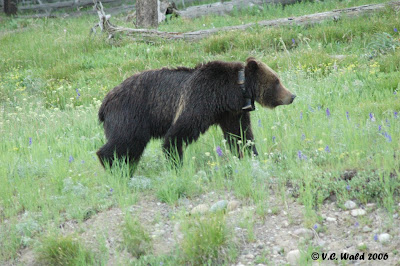The first year I saw her, 399 was sporting a big heavy tracking collar, and in some photos taken at this same sighting, it is apparent that her right front leg had been shaved, most likely to enable blood to be drawn. I would guess that the blood was analyzed for DNA, among other things such as indicators of health. To accomplish collaring and blood sampling (as well as physical measurements including weight, examination of teeth to estimate age, sex determination, and so on) the animal has to be darted and sedated, a dangerous proposition for animal and researchers alike. However, once a particular animal's DNA is on record, subsequently hair rubbed off on the side of a tree (or telephone pole, see Discouraged, But Not Hopeless) or scat can be used to verify whether it is the same individual or another animal.
Behavior is another, less invasive clue; bears are strongly territorial and a sow like 399 is highly likely to return to an area in which she has felt secure raising her young and can find plenty of food and shelter. Probably the only happenstance in which a new sow with cubs would show up in the same vicinity is if 399 were to die and one of her daughters were to take up housekeeping in the area in which she had been raised.
I don't know if 399's collar eventually fell off of its own accord (some are designed to deteriorate), or was intentionally removed, but she definitely didn't have it when I again saw her in 2011. It is possible that by then she had an ear-tag, which, if subtly colored in low light would have been difficult to see. Although as far as I know the tags do not contain a chip that can be read remotely, I wouldn't be surprised if the color were coded for the bear's identity, and the tag itself imprinted with identifying information that could be read close-up should the bear be captured, sedated, or, found deceased.
Tags are common everywhere people and animals interact, such as on this Churchill, Manitoba polar bear, with one in each ear matched to its fur color.
This black bear in Yellowstone National Park is sporting one big red earring. While by no means every Yellowstone bear is tagged, it's not a rare sight. Drives photographers nuts!
Bull moose with radio collar, Grand Tetons.
The elk cow in the right rear has a big collar, Grand Tetons. As is evident in the photos, especially the older tracking collars have big battery-electronics packs. Most are tracked from the ground by graduate students with a device on a belt pack wired to an antenna at the end of an arm slowly turning in the air to pick up the telemetry signals unique to each tracked animal.
Wildlife -- usually in groups like bison herds -- is also visually tracked from the air. If the individuals within the group are known, as wolves are to researchers and other observers, aerial tracking is an effective way of following the movements of individuals of interest.
Tracking plane, Grand Teton National Park. No, it didn't crash into the mountain side, but the view must have been thrilling.
Other methods of tracking wildlife (in addition to a student slowly twirling an antenna overhead) include satellite and GPS tracking, and individual markers like bird bands that require visual contact and a good spotting scope to be read. The Migratory Connectivity Project has good, succinct descriptions of these and other methodologies for tracking mammals, birds, and fish as they cover great distances across the globe. The US Geological Survey (USGS) has a page listing the projects of the Interagency Grizzly Bear Study that gives examples of the various aims of tracking bears. Here's an outline of the Greater Glacier (National Park, north of Yellowstone) Bear DNA Project, in which methods of identifying individual grizzly bears and black bears is described. And for a more comprehensive discussion of radio-tagging (mammals, birds, fish) see the excellent and thoughtful Mech, David L. and Shannon M. Barber, A Critique of Wildlife Radio-Tracking and its Use inNational Parks: A Report to the U.S. National Park Service. February 6, 2002.















_PilgrimCreekRoad_GrizGuyOnCar_DSC0307.jpg)









_EACouse_~1922_oilDSC0055.jpg)
















